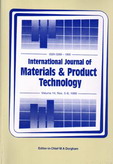Forthcoming Articles
International Journal of Materials and Product Technology

Forthcoming articles have been peer-reviewed and accepted for publication but are pending final changes, are not yet published and may not appear here in their final order of publication until they are assigned to issues. Therefore, the content conforms to our standards but the presentation (e.g. typesetting and proof-reading) is not necessarily up to the Inderscience standard. Additionally, titles, authors, abstracts and keywords may change before publication. Articles will not be published until the final proofs are validated by their authors.
Forthcoming articles must be purchased for the purposes of research, teaching and private study only. These articles can be cited using the expression "in press". For example: Smith, J. (in press). Article Title. Journal Title.
 Articles marked with this shopping trolley icon are available for purchase - click on the icon to send an email request to purchase.
Articles marked with this shopping trolley icon are available for purchase - click on the icon to send an email request to purchase.
Online First articles are also listed here. Online First articles are fully citeable, complete with a DOI. They can be cited, read, and downloaded. Online First articles are published as Open Access (OA) articles to make the latest research available as early as possible.
Register for our alerting service, which notifies you by email when new issues are published online.
International Journal of Materials and Product Technology (4 papers in press) Special Issue on: OA The Application of Advanced Materials for Smart and Sustainable Manufacturing
Abstract: Traditional carbon fibre composite manufacturing processes, such as hand lay-up and moulding, often encounter challenges including complex geometry, low manufacturing precision, and a disconnect between design and manufacturing. Especially when dealing with complex structural designs, it is challenging to precisely control the fibre arrangement and internal structure, resulting in low production efficiency and difficulty in meeting high-performance requirements. This paper applies a 3D printing manufacturing process to provide a more efficient and precise design and manufacturing solution. The design and modelling of carbon fibre composite materials are carried out through computer-aided design (CAD) software, considering factors such as fibre arrangement, stacking order, geometry, and material thickness. The material properties are adjusted according to the requirements, and the model is converted into the STL (stereolithography) format required for 3D printing. Keywords: 3D printing technology; carbon fibre composites; computer-aided design; CAD; finite element analysis; FEA; robot printing technology. DOI: 10.1504/IJMPT.2025.10074218
Abstract: This paper uses finite element analysis and fibre optic sensing technology to dynamically monitor and analyse the stress and strain changes of materials during the removal of reinforced concrete internal support beams, revealing the impact of different removal processes on the mechanical properties of materials. First, a three-dimensional finite element model is established using ANSYS, and the material parameters of the steel bars and concrete are input. Second, fibre optic Bragg grating (FBG) sensors are placed at key locations on the support beams to collect stress and strain data, which are then processed using Python. Finally, BIM technology is used to optimise the demolition sequence, and the impact of dynamic loads on the structure is evaluated based on finite element analysis. The experimental data revealed the effects of different demolition methods on the mechanical properties of reinforced concrete support beams. Keywords: reinforced concrete; demolition process; mechanical properties; finite element analysis; FEA; fibre optic sensor; fibre Bragg grating; FBG. DOI: 10.1504/IJMPT.2025.10074337 Regular Issues
 by Xiaoxia Pan, Haian Yan Abstract: In packaging material research, insufficient attention has been paid to biodegradable and traceable materials. This paper aims to explore the environmental friendliness and application potential of traceable biodegradable packaging materials. This paper modified polylactic acid (PLA) with talc and calcium carbonate (particle size less than 10 microns) at a 20% addition ratio. A traceability system based on Hyperledger Fabric was constructed to enhance transparency, and a life cycle assessment was conducted using SimaPro software. Experimental results showed that the modified PLA exhibited good degradation properties in soil and compost environments, good mechanical and thermal properties, and a total energy consumption of 7.95 MJ and total greenhouse gas emissions of 6.34 kg CO2e over its entire life cycle. These results demonstrate the environmental friendliness of the modified PLA in practical applications and provide new perspectives for future packaging material design, which will contribute to the industry's environmentally friendly development. Keywords: biodegradable materials; traceability system; packaging material sustainability; hyperledger fabric platform; life cycle assessment; LCA. DOI: 10.1504/IJMPT.2025.10073530 Simulation on the mechanical behaviour of polyetheretherketone material under different loading conditions  by Ruoxun Fan, Jie Liu, Huajie Wu, Zhengbin Jia Abstract: Given the increasing demand for lightweight materials, polyetheretherketone (PEEK) is gaining attention as a potential alternative to metals. To evaluate its mechanical suitability for engineering applications, it is necessary to predict the elastic, plastic, and fracture behaviour of PEEK under common loading conditions. The tensile, compressive, and three-point bending experiments were conducted on the PEEK specimens in this study. The yield and failure strains of PEEK were 2.27% and 4.69% in tension and 3.88% and 5.79% in compression. Based on the continuum damage mechanics, the back-calculation analyses were performed to predict the damage variable expression. Subsequently, a simulation model for PEEK under different loading conditions was developed. The back-calculation results identified optimal damage variable yield index (Dy) values of 0.295 for tension and 0.465 for compression. These findings validated the feasibility and applicability of the proposed model, providing a foundation for further investigations into the mechanical properties of PEEK material. Keywords: polyetheretherketone; PEEK; tension; compression; three-point bending; simulation model; continuum damage mechanics; damage variable expression; damage variable yield index; back-calculation. DOI: 10.1504/IJMPT.2025.10074378 |
 Open Access
Open Access